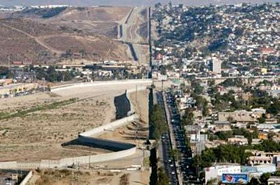 |
 |
 |
 News from Around the Americas | December 2005 News from Around the Americas | December 2005  
Immigration Hits Five-Year High, Report Says
 Stephen Ohlemacher - Associated Press Stephen Ohlemacher - Associated Press


| | Three layers of fences separate the U.S. and Mexico along the border in San Diego. The multiple fences are in place to stop both vehicle and foot traffic from Mexico, to the right of the fences, from coming illegally into the U.S. (Reuters/Fred Greaves) |
Washington - Immigration - both legal and illegal - continues to boom as Congress grapples with how to better control America's borders.

A new report by the Center for Immigration Studies found that 7.9 million people moved to the United States in the past five years, the highest five-year period of immigration on record.

The report, released Monday, comes as the House prepares to take up a bill to curb illegal immigration by boosting border security and requiring workplace enforcement of immigration laws.

There are 35.2 million foreign-born people living in the United States, according to the report, which is based on the Census Bureau's Current Population Survey from March. The report said an estimated 9 million to 13 million are here illegally.

"The 35.2 million immigrants living in the country in March 2005 is the highest number ever recorded - two-and-a-half times the 13.5 million during the peak of the last great immigration wave in 1910," said the report by Steven Camarota, director of research for the Center for Immigration Studies, which advocates tougher policies on illegal immigration and favors attracting immigrants with needed job skills.

About 12.1 percent of the current U.S. population was born in another country, the highest percentage since 1920, according to Census figures.

The report's estimate of the overall number of immigrants living in the United States is consistent with other analyses. But experts warn that it is difficult to accurately measure the number of people entering the country each year.

A recent study by the Pew Hispanic Center found that immigration levels peaked around 2000, then dipped in 2002 and 2003. Nevertheless, Jeffrey Passel, a research associate at the Pew Hispanic Center, said immigration levels remained high, compared with historic levels.

Audrey Singer, an immigration fellow at the Brookings Institution, said, "There's no doubt that we are at a high in immigration to the United States." Singer said immigrants are attracted by economic opportunities and social ties to people already living in the United States.

"Look at places where people come from, these are places with very limited economic opportunities," Singer said.

Mexico is the largest supplier of immigrants to the United States, followed by East Asia, Europe, the Caribbean, Central America and South America, according to the report.

A divided House Judiciary Committee approved a bill last week that would enlist military support in border surveillance and set new mandatory minimum sentences on smugglers and people convicted of re-entry after removal. Illegal presence in the country, now a civil offense, would become a federal crime.

The full House is expected to take up the measure this week, before it adjourns for the year.

President Bush has proposed a guest worker program that could allow illegal immigrants to stay in the country temporarily to fill jobs unwanted by Americans.

The guest worker provision is not part of the House bill.

Activists have been arguing for years that America needs to better secure its borders against illegal immigrants, while others argue that the American economy would collapse without the cheap labor provided by undocumented workers.

The Center for Immigration Studies report says that immigrants, on average, are less educated and more likely to live in poverty than people born in the United States.

The Pew Hispanic Center, however, says that education levels are improving among recent immigrants.

Camarota said the U.S. should work harder to expel people who are in the United States illegally.

"The obvious thing is to enforce the law, at the border and at the work site, and to deny access to bank accounts and driver licenses," Camarota said.

But Angela Kelley, deputy director of the National Immigration Forum, said it would be impossible to deport as many as 11 million illegally immigrants, who make up about 5 percent of the U.S. work force.

"There isn't fairy dust that is going to make the 11 million people go away," Kelley said. "It would be far more sensible to have them come out into the light of day ... and give them a chance to join the American family on a permanent basis."

Center for Immigration Studies: http://www.cis.org/
National Immigration Forum: http://www.immigrationforum.org/ | 
 | |
 |



